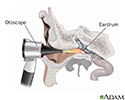Tympanometry
Tympanogram; Otitis media - tympanometry; Effusion - tympanometry; Immittance testing
Tympanometry is a test used to detect problems in the ear drum and middle ear.
How the Test is Performed
Before the test, your health care provider will look inside your ear to make sure nothing is blocking the eardrum.
Next, a device is placed into your ear. This device changes the air pressure in your ear and makes the eardrum move back and forth. A machine records the results on graphs called tympanograms.
How to Prepare for the Test
You should not move, speak, or swallow during the test. Such movements can change the pressure in the middle ear and give incorrect test results.
The sounds heard during the test may be loud. This may be startling. You will need to try very hard to stay calm and not get startled during the test. If your child is to have this test done, it may be helpful to show how the test is done using a doll. The more your child knows what to expect and why the test is done, the less nervous your child will be.
How the Test will Feel
There may be some discomfort while the probe is in the ear, but no harm will result. You will hear a loud tone and feel pressure in your ear as the measurements are taken.
Why the Test is Performed
This test measures how your ear reacts to sound and different pressures.
Normal Results
The pressure inside the middle ear can vary by a very small amount. The eardrum should look smooth.
What Abnormal Results Mean
Tympanometry may reveal any of the following:
- A tumor in the middle ear
- Fluid in the middle ear
- Impacted ear wax
- Lack of contact between the conduction bones of the middle ear
- Perforated eardrum
- Scarring of the eardrum
- Eustachian tube dysfunction
Risks
There are no risks with this test.
References
Player B. Otitis media. In: Kliegman RM, St. Geme JW, Blum NJ, et al, eds. Nelson Textbook of Pediatrics. 22nd ed. Philadelphia, PA: Elsevier; 2025:chap 680.
Woodson E, Mowry S. Otologic symptoms and syndromes. In: Flint PW, Francis HW, Haughey BH, et al, eds. Cummings Otolaryngology: Head and Neck Surgery. 7th ed. Philadelphia, PA: Elsevier; 2021:chap 137.
Review Date: 5/2/2024





